Electronegativities - Study guides, Class notes & Summaries
Looking for the best study guides, study notes and summaries about Electronegativities? On this page you'll find 220 study documents about Electronegativities.
All 220 results
Sort by
 Popular
Popular
-
Chem 103 Module 1 to 6 Exam with Verified answers (100 OUT OF 100) Portage learning (Latest Update)
- Exam (elaborations) • 35 pages • 2024
- Available in package deal
-
- $20.49
- 15x sold
- + learn more
Chem 103 Module 1 to 6 Exam with Verified answers (100 OUT OF 100) Portage learning (Latest Update) MODULE 1 EXAM Question 1 Click this link to access the Periodic Table. This may be helpful throughout the exam. 1. Convert 845.3 to exponential form and explain your answer. 2. Convert 3.21 x 10-5 to ordinary form and explain your answer. 1. Convert 845.3 = larger than 1 = positive exponent, move decimal 2 places = 8.453 x 102 2. Convert 3.21 x 10-5 = negative exponent = smalle...
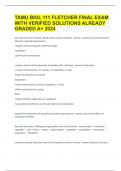 Popular
Popular
-
TAMU BIOL 111 FLETCHER FINAL EXAM WITH VERIFIED SOLUTIONS ALREADY GRADED A+
- Exam (elaborations) • 36 pages • 2023 Popular
- Available in package deal
-
- $14.99
- 1x sold
- + learn more
describe the basic functions all life forms must accomplish -response to environmental stimuli & maintain homeostasis -uptake and processing of nutrients/energy -regulation -growth and reproduction compare and contrast eukaryotic and prokaryotic cell types Prokaryotes: -circular chromosomes, no nucleus, no organelles, 3.5 bya -DNA concentrated in nucleoid Eukaryotes: -linear chromosomes, nucleus, organelles, 1.5 bya -DNA concentrated in nucleus Both: -cellular function takes p...
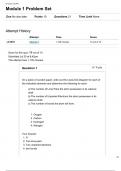
-
CHEM 219 Module 1 Problem Set Principles of Organic Chemistry with Lab Gallaher Portage Learning.
- Exam (elaborations) • 18 pages • 2024
- Available in package deal
-
- $11.99
- 1x sold
- + learn more
CHEM 219 Module 1 Problem Set Principles of Organic Chemistry with Lab Gallaher Portage Learning. Score for this quiz: 10 out of 10 Submitted Jul 25 at 8:42pm This attempt took 1,135 minutes. Question 1 0 / 0 pts Your Answer: On a piece of scratch paper, write out the Lewis Dot Diagram for each of the indicated elements and determine the following for each: a) The number of Lone Pairs the atom possesses in its valence shell. b) The number of Unpaired Electrons the atom possesses in its...
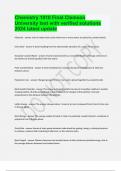
-
Chemistry 1010 Final Clemson University test with verified solutions 2024 latest update.
- Exam (elaborations) • 10 pages • 2024
- Available in package deal
-
- $14.99
- 1x sold
- + learn more
Molecule Unit of matter that results when two or more atoms are joined by covalent bonds Ionic Bond A bond resulting from the electrostatic attraction of a cation for an anion. Brainpower Read More Nonpolar Covalent Bond A bond characterized by an even distribution of charge; electrons in the bonds are shared equally by the two atoms Polar Covalent Bond A bond resulting from unequal sharing of bonding pairs of electrons between atoms Polyatomic Ions Charged g...
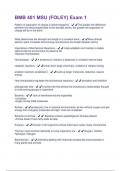
-
BMB 401 MSU (FOLEY) Exam 1 (Questions and answers) LATEST UPDATE
- Exam (elaborations) • 22 pages • 2024
- Available in package deal
-
- $7.99
- + learn more
Pattern of separation of charge in electronegativity - ️️The greater the difference between the electronegativities of two bonded atoms, the greater the separation of charge will be in the bond What determines the strength and length of a covalent bond - ️️More shared electron pairs increases bond energy and shortens the length between atoms Importance of Biochemical Reactions - ️️-Help establish and maintain a stable optimal internal environment to preserve life -Maintain Hom...
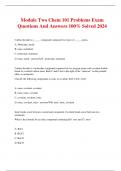
-
Module Two Chem 101 Problems Exam Questions And Answers 100% Solved 2024
- Exam (elaborations) • 25 pages • 2024
-
- $13.49
- + learn more
Module Two Chem 101 Problems Exam Questions And Answers 100% Solved 2024 Carbon dioxide is a _____ compound composed two types of _____ atoms. A. Molecular, metal B. ionic, metalloid C. molecular, nonmetal D. ionic, metal - answerC. molecular, nonmetal Carbon dioxide is a molecular compound composed of two oxygen atoms with covalent double bonds to a central carbon atom. Both C and O are to the right of the "staircase" on the periodic table, as nonmetals. Classify the following compo...
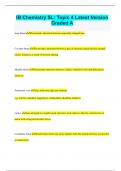
-
IB Chemistry SL: Topic 4 Latest Version Graded A
- Exam (elaborations) • 30 pages • 2024
- Available in package deal
-
- $10.49
- + learn more
IB Chemistry SL: Topic 4 Latest Version Graded A Ionic Bond Electrostatic attraction between oppositely charged ions Covalent Bond Electrostatic attraction between a pair of electrons and positively charged nuclei, formed as a result of electron sharing Metallic Bond Electrostatic attraction between a lattice of positive ions and delocalized electrons Polyatomic ions ions with more than one element e.g. CaCO3, Al(OH)3, Mg(NO3)2, (NH4)2SO4, Ba3PO4, LiHCO3 Lattice ions arran...
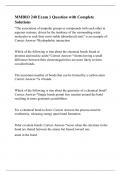
-
MMBIO 240 Exam 1 Question with Complete Solutions
- Exam (elaborations) • 13 pages • 2024
-
- $16.49
- + learn more
"The association of nonpolar groups or compounds with each other in aqueous systems, driven by the tendency of the surrounding water molecules to seek their most stable (disordered) state" is an example of: Correct Answer-*Hydrophobic interaction Which of the following is true about the chemical bonds found in proteins and nucleic acids? Correct Answer-*Atoms having a small difference between their electronegativities are more likely to form covalent bonds. The maximum number of bonds th...
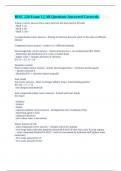
-
BISC 220 Exam 1 || All Questions Answered Correctly.
- Exam (elaborations) • 19 pages • 2024
-
- $12.99
- + learn more
Valency correct answers How many electrons the atom need to fill shell - Shell 1: 2e- - Shell 2: 8e- - Shell 3: 18e- Covalent bonds correct answers - Sharing of electrons between atoms of the same or different element Compound correct answers - combo of 2+ different elements Electronegativity correct answers - Atoms attraction for e- in covalent bond (EX: H2O) - Determines the distribution of e- w/in a covalent bond - higher value = stronger attraction of electrons EX: O = 3.5...
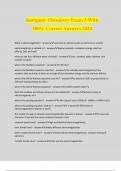
-
Inorganic Chemistry Exam 3 With 100% Correct Answers 2024
- Exam (elaborations) • 12 pages • 2024
- Available in package deal
-
- $11.49
- + learn more
Inorganic Chemistry Exam 3 With 100% Correct Answers 2024 What is electronegativity? - answerhow hard an element pulls on electrons in a bond electronegativity is related to? - answerdipole moments, ionization energy, electron affinity, Zeff, and radii what are the four different types of bonds? - answerionic, covalent, polar covalent, and metallic covalent what is the Mulliken equation? - answerX=EA+IE/2 what is the Mulliken equation used for? - answerto calculate electronegativity from...

$6.50 for your textbook summary multiplied by 100 fellow students... Do the math: that's a lot of money! Don't be a thief of your own wallet and start uploading yours now. Discover all about earning on Stuvia


